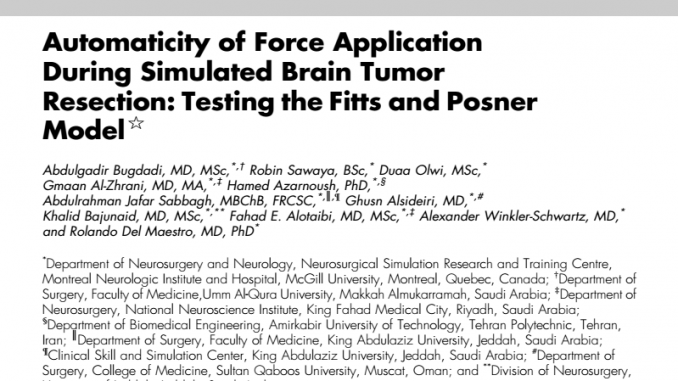
[PDF]
Journal of Surgical Education 2017 Jul 3: [e-pub ahead of print]
Bugdadi A, Sawaya R, Olwi D, Al-Zahrani G, Azarnoush H, Sabbagh A, Alsideiri G, Bajunaid K, Alotaibi FE, Winkler-Schwartz A, Del Maestro RF
OBJECTIVE: The Fitts and Posner model of motor learning hypothesized that with deliberate practice, learners progress through stages to an autonomous phase of motor ability. To test this model, we assessed the automaticity of neurosurgeons, senior residents, and junior residents when operating on 2 identical tumors using the NeuroVR virtual reality simulation platform.
DESIGN: Participants resected 9 identical simulated tumors on 2 occasions (total 1⁄4 18 resections). These resections were separated by the removal of a variable number of tumors with different visual and haptic complexities to mirror neurosurgical practice. Consistency of force application was used as a metric to assess automaticity and was defined as applying forces 1 standard deviation above or below a specific mean force application. Amount and specific location of force application during second identical tumor resection was compared to that used for the initial tumor.
SETTING: This study was conducted at the McGill Neuro-
surgical Simulation Research and Training Center, Mon-
treal Neurologic Institute and Hospital, Montreal, Canada.
PARTICIPANTS: Nine neurosurgeons, 10 senior residents, and 8 junior residents.
RESULTS: Neurosurgeons display statistically significant increased consistency of force application when compared to resident groups when results from all tumor resections were assessed. Assessing individual tumor types demonstrates significant differences between the neurosurgeon and resident groups when resecting hard stiffness similar-to-background (white) tumors and medium-stiffness tumors. No statistical difference in consistency of force application was found when junior and senior residents were compared.
CONCLUSION: “Experts” display significantly more automaticity when operating on identical simulated tumors separated by a series of different tumors using the NeuroVR platform. These results support the Fitts and Posner model of motor learning and are consistent with the concept that automaticity improves after completing residency training. The potential educational application of our findings is outlined related to neurosurgical resident training.
